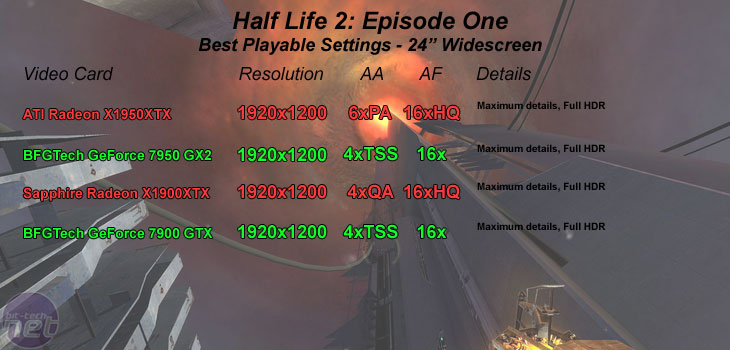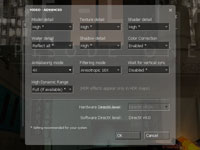For gameplay evaluations on a CRT, please head back to our CRT performance section.
Half-Life 2: Episode One is the first in a series of episodes that extends the Half-Life 2 story far beyond where the original left off. Valve has implemented its HDR rendering and used it to great effect in Half-Life 2: Episode One. There are also new higher-resolution textures, new facial animations and some AI improvements made in the new game too.
Anti-aliasing and anisotropic filtering were controlled from inside the game, and thus the drivers were left set to "Application Controlled". There are three options for the method of HDR used in this title. You can either disable HDR completely, make use of "Bloom" which is just what it says and less resource hungry in comparison to "Full" which, again is just what it says. It utilises a full dynamic range with the iris effect too.
We have written quite a bit about Half-Life 2: Lost Coast, Day of Defeat: Source, Episode One and how Valve have implemented HDR in to the Source Engine. You can check out the articles listed below for more information on The Lost Coast & Day of Defeat: Source.
We did a five minute manual run through from the Exit 17 level. It involves lots of HDR, lots of explosions and both indoor and outdoor scenes. The section we have used is typical of some of the more stressful areas in the game. Thankfully though, the game runs superbly on a wide range of hardware, while still looking absolutely stunning.

 The Radeon X1950XTX delivered the best gaming experience we've ever had in Half-Life 2: Episode One while using a single video card. It was even capable of delivering higher playable image quality than the GeForce 7950 GX2. With 6x performance adaptive AA and 16x HQ AF, the frame rate never dropped below 30 frames per second, while the average was a very smooth 55 fps.
The Radeon X1950XTX delivered the best gaming experience we've ever had in Half-Life 2: Episode One while using a single video card. It was even capable of delivering higher playable image quality than the GeForce 7950 GX2. With 6x performance adaptive AA and 16x HQ AF, the frame rate never dropped below 30 frames per second, while the average was a very smooth 55 fps.
We tried playing the game with 6x quality adaptive AA enabled, but it resulted in a less-than-smooth gaming experience, although it wasn't quite as choppy as trying to play the game with 8xAA enabled on the GeForce 7950 GX2. The frame rate dropped below 30fps on quite a few occasions on the Radeon X1950XTX, while it was dropping below 20fps on the GeForce 7950 GX2 far too often, such that we felt it impacted the gaming experience.
The texture filtering quality was much better on the Radeon X1950XTX, even with the high quality driver option forced in NVIDIA's control panel. However, if there was anything that marred the immersive gaming experience we enjoyed on the Radeon X1950XTX, it was that the transparent texture aliasing was slightly worse than what we were seeing on the GeForce 7950 GX2, by virtue of the fact we were using the performance adaptive AA option - you can see some quality comparisons in our Transparency & Adaptive AA feature.
Half-Life 2: Episode One
Publisher: Valve SoftwareHalf-Life 2: Episode One is the first in a series of episodes that extends the Half-Life 2 story far beyond where the original left off. Valve has implemented its HDR rendering and used it to great effect in Half-Life 2: Episode One. There are also new higher-resolution textures, new facial animations and some AI improvements made in the new game too.
Anti-aliasing and anisotropic filtering were controlled from inside the game, and thus the drivers were left set to "Application Controlled". There are three options for the method of HDR used in this title. You can either disable HDR completely, make use of "Bloom" which is just what it says and less resource hungry in comparison to "Full" which, again is just what it says. It utilises a full dynamic range with the iris effect too.
We have written quite a bit about Half-Life 2: Lost Coast, Day of Defeat: Source, Episode One and how Valve have implemented HDR in to the Source Engine. You can check out the articles listed below for more information on The Lost Coast & Day of Defeat: Source.
- Half-Life 2: Lost Coast HDR overview
- Half-Life 2: Lost Coast hands on
- Half-Life 2: Lost Coast Benchmarks & Video
- Cinematic Effects in Source
- Liveblogging HL2: Episode One
We did a five minute manual run through from the Exit 17 level. It involves lots of HDR, lots of explosions and both indoor and outdoor scenes. The section we have used is typical of some of the more stressful areas in the game. Thankfully though, the game runs superbly on a wide range of hardware, while still looking absolutely stunning.


We tried playing the game with 6x quality adaptive AA enabled, but it resulted in a less-than-smooth gaming experience, although it wasn't quite as choppy as trying to play the game with 8xAA enabled on the GeForce 7950 GX2. The frame rate dropped below 30fps on quite a few occasions on the Radeon X1950XTX, while it was dropping below 20fps on the GeForce 7950 GX2 far too often, such that we felt it impacted the gaming experience.
The texture filtering quality was much better on the Radeon X1950XTX, even with the high quality driver option forced in NVIDIA's control panel. However, if there was anything that marred the immersive gaming experience we enjoyed on the Radeon X1950XTX, it was that the transparent texture aliasing was slightly worse than what we were seeing on the GeForce 7950 GX2, by virtue of the fact we were using the performance adaptive AA option - you can see some quality comparisons in our Transparency & Adaptive AA feature.

MSI MPG Velox 100R Chassis Review
October 14 2021 | 15:04










Want to comment? Please log in.